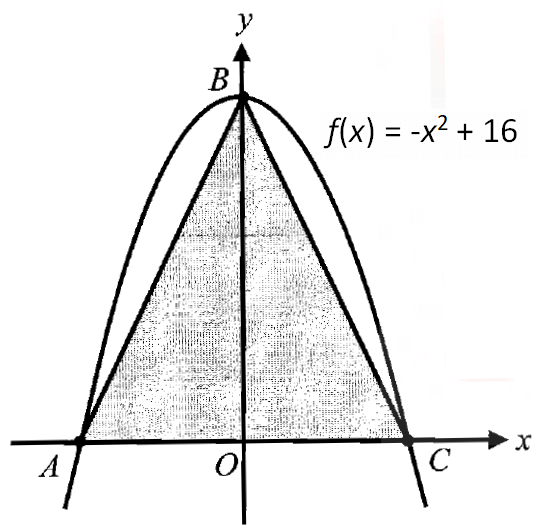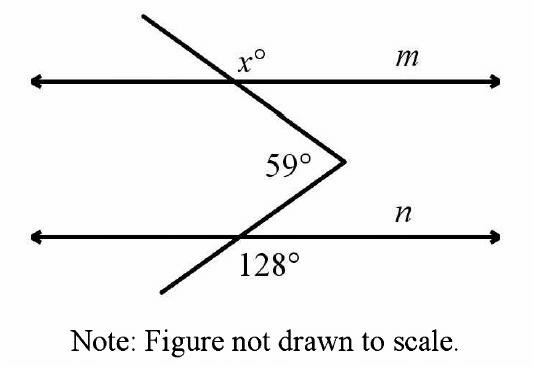DIGITAL SAT MATH PROBLEMS AND SOLUTIONS
(Part - 34)
Problem 1 :

Human blood can be
classified into four common blood types—A, B, AB, and O. It is also
characterized by the presence (+) or absence (–) of the rhesus factor. The
table above shows the distribution of blood type and rhesus factor for a group
of people. If one of these people who is rhesus negative (–) is chosen at
random, the probability that the person has blood type B is 1/9. What is the
value of x?
Solution :

Problem 2 :
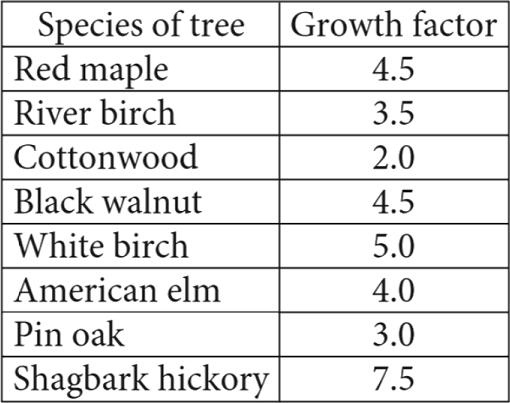
One method of calculating the approximate age, in years, of a tree of a particular species is to multiply the diameter of the tree, in inches, by a constant called the growth factor for that species. The table above gives the growth factors for eight species of trees. If a white birch tree and a pin oak tree each now have a diameter of 1 foot, which of the following will be closest to the difference,in inches,of their diameters 10 years from now?(1 foot = 12 inches)
A) 1.0
B) 1.2
C) 1.3
D) 1.4
Solution :

Problem 3 :
The scatterplot below shows the amount of electric energy generated, in millions of megawatt-hours, by nuclear sources over a 10-year period.
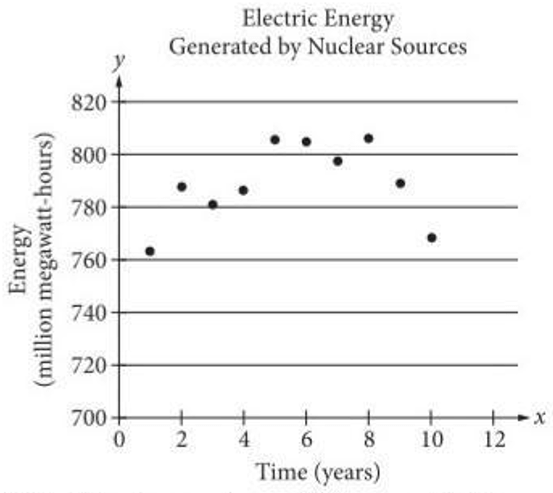
Of the following
equations, which best models the data in the scatterplot?
A) y = 1.674x2 + 19.76x – 745.73
B) y = -1.674x2 - 19.76x – 745.73
C) y = 1.674x2 + 19.76x + 745.73
D) y = -1.674x2 + 19.76x + 745.73
Solution :

Problem 4 :
y < 6x + 2
For which of the following tables are all the values of x and their corresponding values of y solutions to the given inequality?
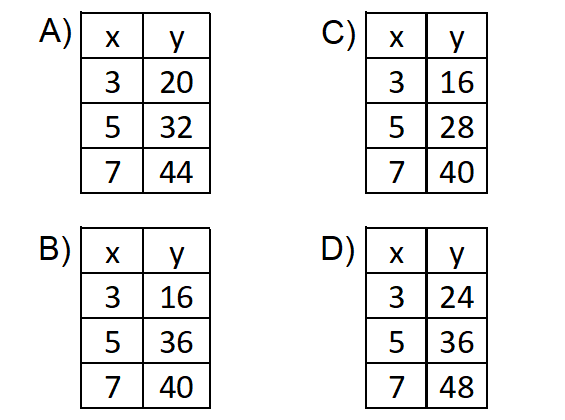
Solution :

Problem 5 :
A psychologist set up an experiment to study the tendency of a person to select the first item when presented with a series of items. In the experiment, 300 people were presented with a set of five pictures arranged in random order. Each person was asked to choose the most appealing picture. Of the first 150 participants, 36 chose the first picture in the set. Among the remaining 150 participants, p people chose the first picture in the set. If more than 20% of all participants chose the first picture in the set, which of the following inequalities best describes the possible values of p?
A) p > 0.20(300−36), where p ≤ 150
B) p > 0.20(300+36), where p ≤ 150
C) p – 36 > 0.20(300), where p ≤ 150
D) p + 36 > 0.20(300), where p ≤ 150
Solution :

You might like these
Digital SAT Problems and Solutions (Part - 1)
Digital SAT Problems and Solutions (Part - 2)
Digital SAT Problems and Solutions (Part - 3)
Digital SAT Problems and Solutions (Part - 4)
Digital SAT Problems and Solutions (Part - 5)
Digital SAT Problems and Solutions (Part - 6)
Digital SAT Problems and Solutions (Part - 7)
Digital SAT Problems and Solutions (Part - 8)
Digital SAT Problems and Solutions (Part - 9)
Digital SAT Problems and Solutions (Part - 10)
Digital SAT Problems and Solutions (Part - 11)
Digital SAT Problems and Solutions (Part - 12)
Digital SAT Problems and Solutions (Part - 13)
Digital SAT Problems and Solutions (Part - 14)
Digital SAT Problems and Solutions (Part - 15)
Digital SAT Problems and Solutions (Part - 16)
Digital SAT Problems and Solutions (Part - 17)
Digital SAT Problems and Solutions (Part - 18)
Digital SAT Problems and Solutions (Part - 19)
Digital SAT Problems and Solutions (Part - 20)
Digital SAT Problems and Solutions (Part - 21)
Digital SAT Problems and Solutions (Part - 22)
Digital SAT Problems and Solutions (Part - 23)
Digital SAT Problems and Solutions (Part - 24)
Digital SAT Problems and Solutions (Part - 25)
Digital SAT Problems and Solutions (Part - 26)
Digital SAT Problems and Solutions (Part - 27)
Digital SAT Problems and Solutions (Part - 28)
Digital SAT Problems and Solutions (Part - 29)
Digital SAT Problems and Solutions (Part - 30)
Digital SAT Problems and Solutions (Part - 31)
Digital SAT Problems and Solutions (Part - 32)
Digital SAT Problems and Solutions (Part - 33)
Digital SAT Problems and Solutions (Part - 34)
Digital SAT Problems and Solutions (Part - 35)
Digital SAT Problems and Solutions (Part - 36)
Digital SAT Problems and Solutions (Part - 37)
Digital SAT Problems and Solutions (Part - 38)
Digital SAT Problems and Solutions (Part - 39)
Digital SAT Problems and Solutions (Part - 40)
Digital SAT Problems and Solutions (Part - 41)
Digital SAT Problems and Solutions (Part - 42)
Digital SAT Problems and Solutions (Part - 43)
Digital SAT Problems and Solutions (Part - 44)
Digital SAT Problems and Solutions (Part - 45)
Digital SAT Problems and Solutions (Part - 46)
Digital SAT Problems and Solutions (Part - 47)
Digital SAT Problems and Solutions (Part - 48)
Digital SAT Problems and Solutions (Part - 49)
Digital SAT Problems and Solutions (Part - 50)
Digital SAT Problems and Solutions (Part - 51)
Digital SAT Problems and Solutions (Part - 52)
Digital SAT Problems and Solutions (Part - 53)
Digital SAT Problems and Solutions (Part - 54)
Digital SAT Problems and Solutions (Part - 55)
Digital SAT Problems and Solutions (Part - 56)
Digital SAT Problems and Solutions (Part - 57)
Digital SAT Problems and Solutions (Part - 58)
Digital SAT Problems and Solutions (Part - 59)
Digital SAT Problems and Solutions (Part - 60)
Digital SAT Problems and Solutions (Part - 61)
Digital SAT Problems and Solutions (Part - 62)
Digital SAT Problems and Solutions (Part - 63)
Digital SAT Problems and Solutions (Part - 64)
Digital SAT Problems and Solutions (Part - 65)
Digital SAT Problems and Solutions (Part - 66)
Digital SAT Problems and Solutions (Part - 67)
Digital SAT Problems and Solutions (Part - 68)
Digital SAT Problems and Solutions (Part - 69)
Digital SAT Problems and Solutions (Part - 70)
Digital SAT Problems and Solutions (Part - 71)
Digital SAT Problems and Solutions (Part - 72)
Digital SAT Problems and Solutions (Part - 73)
Digital SAT Problems and Solutions (Part - 74)
Digital SAT Problems and Solutions (Part - 75)
Digital SAT Problems and Solutions (Part - 76)
Digital SAT Problems and Solutions (Part - 77)
Digital SAT Problems and Solutions (Part - 78)
Digital SAT Problems and Solutions (Part - 79)
Digital SAT Problems and Solutions (Part - 80)
Digital SAT Problems and Solutions (Part - 81)
Digital SAT Problems and Solutions (Part - 82)
Digital SAT Problems and Solutions (Part - 83)
Digital SAT Problems and Solutions (Part - 84)
Digital SAT Problems and Solutions (Part - 85)
Digital SAT Problems and Solutions (Part - 86)
Digital SAT Problems and Solutions (Part - 87)
Digital SAT Problems and Solutions (Part - 88)
Digital SAT Problems and Solutions (Part - 89)
Digital SAT Problems and Solutions (Part - 90)
Digital SAT Problems and Solutions (Part - 91)
Digital SAT Problems and Solutions (Part - 92)
Digital SAT Problems and Solutions (Part - 93)
Digital SAT Problems and Solutions (Part - 94)
Digital SAT Problems and Solutions (Part - 95)
Digital SAT Problems and Solutions (Part - 96)
Digital SAT Problems and Solutions (Part - 97)
Digital SAT Problems and Solutions (Part - 98)
Digital SAT Problems and Solutions (Part - 99)
Digital SAT Problems and Solutions (Part - 100)
Digital SAT Problems and Solutions (Part - 101)
Digital SAT Problems and Solutions (Part - 102)
Digital SAT Problems and Solutions (Part - 103)
Digital SAT Problems and Solutions (Part - 104)
Digital SAT Problems and Solutions (Part - 105)
Digital SAT Problems and Solutions (Part - 106)
Digital SAT Problems and Solutions (Part - 107)
Digital SAT Problems and Solutions (Part - 108)
Digital SAT Problems and Solutions (Part - 109)
Digital SAT Problems and Solutions (Part - 110)
Digital SAT Problems and Solutions (Part - 111)
Digital SAT Problems and Solutions (Part - 112)
Digital SAT Problems and Solutions (Part - 113)
Digital SAT Problems and Solutions (Part - 114)
Digital SAT Problems and Solutions (Part - 115)
Digital SAT Problems and Solutions (Part - 116)
Digital SAT Problems and Solutions (Part - 117)
Digital SAT Problems and Solutions (Part - 118)
Digital SAT Problems and Solutions (Part - 119)
Digital SAT Problems and Solutions (Part - 120)
Digital SAT Problems and Solutions (Part - 121)
Digital SAT Problems and Solutions (Part - 122)
Digital SAT Problems and Solutions (Part - 123)
Digital SAT Problems and Solutions (Part - 124)
Digital SAT Problems and Solutions (Part - 125)
Digital SAT Problems and Solutions (Part - 126)
Digital SAT Problems and Solutions (Part - 127)
Digital SAT Problems and Solutions (Part - 127)
Digital SAT Problems and Solutions (Part - 128)
Digital SAT Problems and Solutions (Part - 129)
Digital SAT Problems and Solutions (Part - 130)
Digital SAT Problems and Solutions (Part - 131)
Digital SAT Problems and Solutions (Part - 132)
Digital SAT Problems and Solutions (Part - 133)
Digital SAT Problems and Solutions (Part - 134)
Digital SAT Problems and Solutions (Part - 135)
Digital SAT Problems and Solutions (Part - 136)
Digital SAT Problems and Solutions (Part - 137)
Digital SAT Problems and Solutions (Part - 138)
Digital SAT Problems and Solutions (Part - 139)
Digital SAT Problems and Solutions (Part - 140)
Digital SAT Problems and Solutions (Part - 141)
Digital SAT Problems and Solutions (Part - 142)
Digital SAT Problems and Solutions (Part - 143)
Kindly mail your feedback to v4formath@gmail.com
We always appreciate your feedback.
©All rights reserved. onlinemath4all.com
Recent Articles
-
Digital SAT Math Problems and Solutions (Part - 143)
Apr 13, 25 12:01 PM
Digital SAT Math Problems and Solutions (Part - 143) -
Quadratic Equation Problems with Solutions
Apr 12, 25 08:21 PM
Quadratic Equation Problems with Solutions -
Digital SAT Math Problems and Solutions (Part - 142)
Apr 11, 25 06:26 PM
Digital SAT Math Problems and Solutions (Part - 142)
